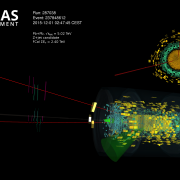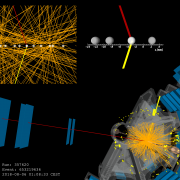Access to Collaboration Site and Physics Results
STOCKHOLM, 19 JULY: The top quark is the heaviest known fundamental particle, which makes it an extremely interesting object to study. It interacts very strongly with the Higgs boson because of its large mass, so it is essential that the properties of the top quark are measured as precisely as possible.
At the EPS HEP conference today, ATLAS released a new precise measurement of the top quark mass using events where both top quarks decay via W bosons to electrons or muons. ATLAS also presented limits on the possibility of the top quark decaying to channels not foreseen in the Standard Model. A comparison of the behaviour of top quarks and anti-top quarks produced at the LHC is in agreement with the prediction of the Standard Model, disfavouring models of new physics that require a large top/anti-top asymmetry.

ATLAS physicists are currently presenting new results at the biennial Europhysics conference on High Energy Physics. The week-long conference, which is taking place in Stockholm, Sweden, is organized by the High Energy and Particle Physics Division of the European Physical Society (EPS). Various new ATLAS results are being presented, including studies in B physics, precision measurements of the Top quark, searches for Supersymmetry and other Exotic physics models, as well as refined measurements of the properties of the Higgs boson, with many results now based on the full 2012 data set.
EPS-HEP is one of the major international conferences in the field of high energy physics, with more than 700 participants.
Links:
- ATLAS Experiment - Public Results
- ATLAS Experiment - CONF notes
- Interview with Peter Jenni
- Highlights from EPS-HEP 2013
- CERN experiments to present results at summer conferences








